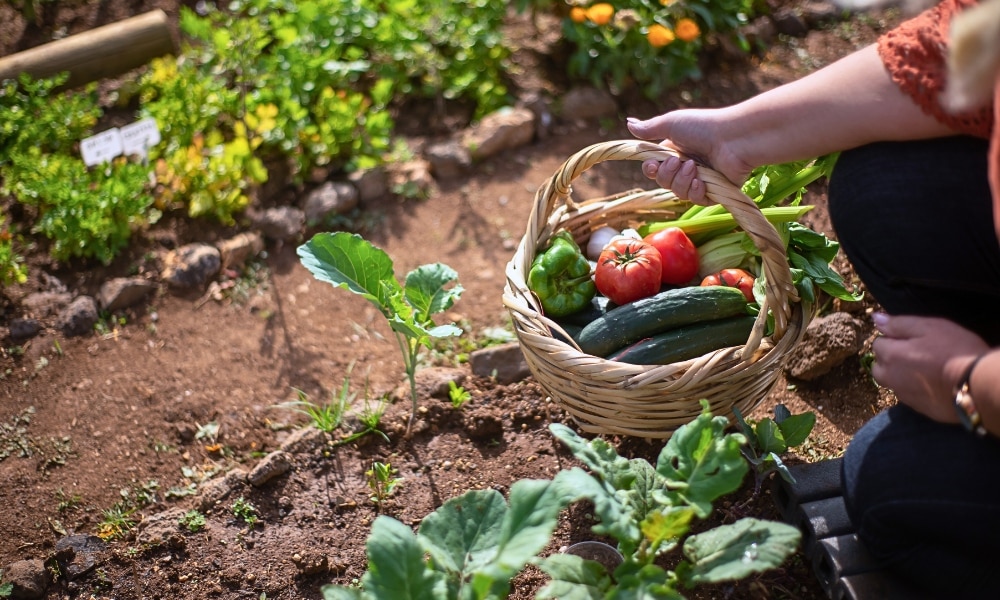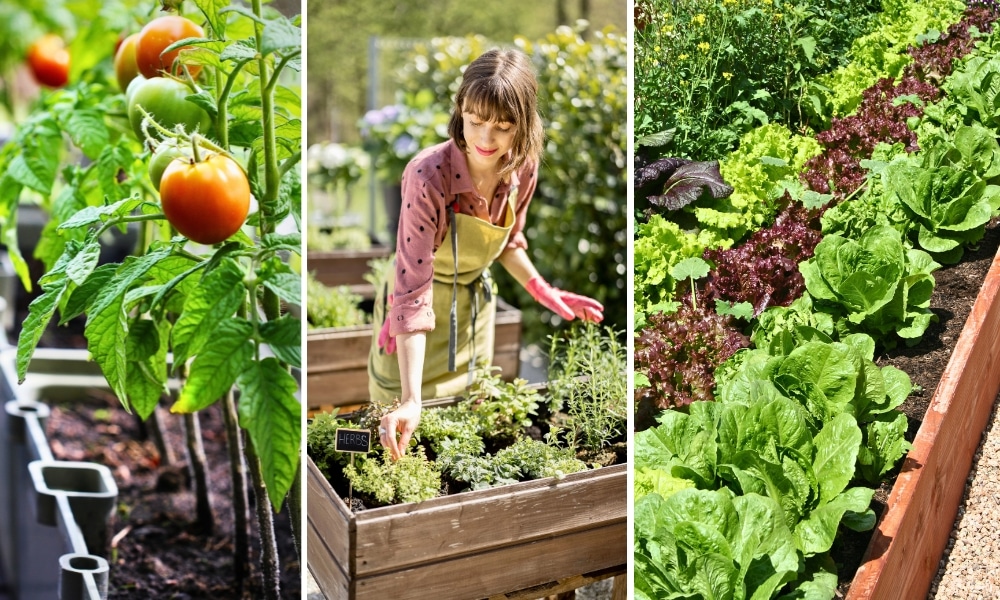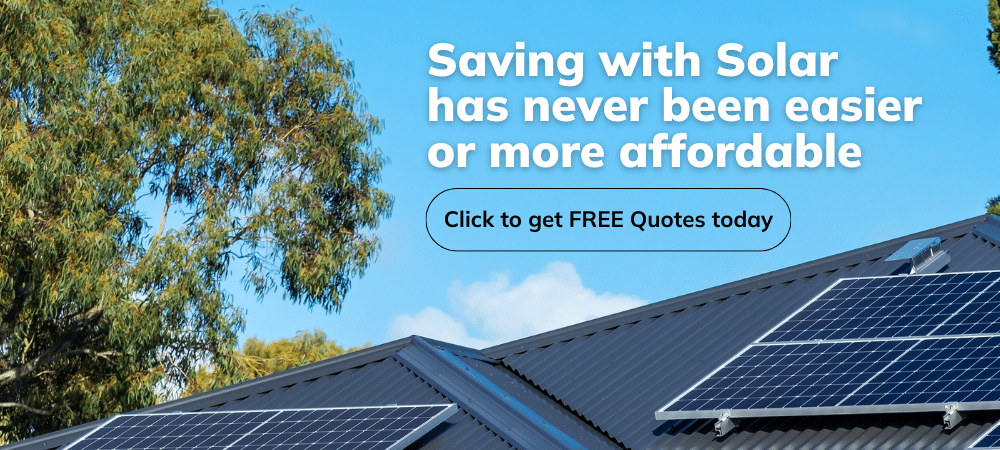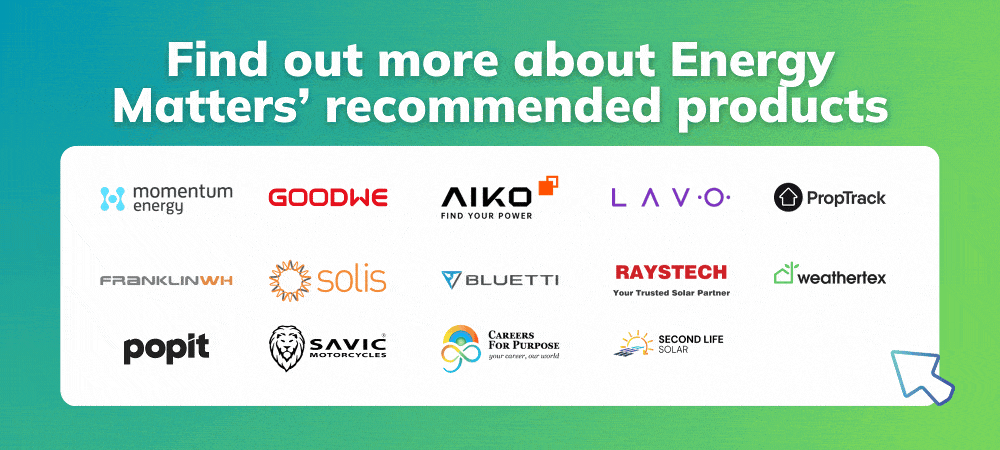Creating a sustainable home garden is an excellent way to contribute to environmental conservation while enjoying the benefits of fresh produce and beautiful greenery. By incorporating solar-powered lighting, you can enhance your garden’s efficiency, reducing reliance on grid electricity and minimising your carbon footprint.
This guide will provide practical eco-friendly gardening tips to help you grow a green garden using sustainable methods. Read on to discover how to make your garden self-sufficient and environmentally friendly.

On this page
Understanding why sustainable home gardening matters
Sustainable home gardening goes beyond growing plants; it involves using environmentally friendly methods to conserve water, enrich the soil, and support biodiversity. It reduces waste, lowers energy consumption, and helps combat climate change. Integrating solar-powered lighting allows you to garden efficiently while reducing your reliance on non-renewable energy sources.
Ready to harness the power of the sun and secure your solar energy future?
Energy Matters is one of Australia’s most trusted solar quotes due to our high customer satisfaction and industry recommendations. Our team of solar experts can help you get up to 3 FREE solar quotes from pre-qualified and vetted solar firms in your area.
Cultivating a green oasis
Let’s explore how you can transform your backyard into a thriving, sustainable ecosystem.
1. Planning your sustainable garden
Before you start digging, careful planning is crucial. Consider the following factors:
Climate and location: Australia’s diverse climate zones necessitate tailoring your plant choices and gardening practices. Research your region’s average rainfall, temperature extremes, and frost periods. This information is readily available from the Bureau of Meteorology (BOM) website (bom.gov.au). Understanding your local climate will inform your plant selection, planting times, and watering needs. For example, a garden in Tasmania will have very different requirements than one in Darwin.
Sunlight: Observe your yard throughout the day to determine areas that receive full sun (at least six hours) and partial and complete shade. This will dictate where you plant different vegetables, herbs, and flowers. Most fruiting vegetables need full sun to thrive.
Soil type: Australian soils vary widely, from sandy to clay. Understanding your soil type is essential for choosing appropriate plants and soil amendments. A simple DIY soil test or a professional soil analysis can provide valuable insights. Amendments like compost and aged manure can improve soil structure and fertility.
Water availability: Water is a precious resource, especially in Australia. Consider water-wise gardening practices from the outset. This includes installing a rainwater tank (check local government rebates for potential savings), using efficient irrigation methods like drip irrigation, and grouping plants with similar water needs together.
Garden size and layout: Realistically assess your available space and plan your garden layout accordingly. Consider creating raised garden beds if your soil is poor or drainage is an issue. A well-planned layout will make gardening more enjoyable and efficient.
Plant selection: Choose plants well-suited to your climate, soil type, and sunlight conditions. Prioritise native plants, as they are adapted to the local environment and require less maintenance. Native plants also attract native wildlife, contributing to a healthy ecosystem. Consider incorporating vegetables, herbs, flowers, and fruit trees for a diverse and productive garden.
Budget: Gardening can be as expensive or as budget-friendly as you want. Set a realistic budget and stick to it. Starting with seeds rather than seedlings can save money. Utilise resources like community gardens and seed-sharing programs.
Did you know Energy Matters is Australia’s largest renewable news, blog and educational resource? Subscribe to Energy Matters’ weekly newsletter and keep updated even with incentives, rebates and recommended solar product offers.
2. Choosing sustainable plants and crops
A sustainable home garden thrives on the right selection of plants. Choosing low-maintenance, drought-resistant, and native species reduces water usage and promotes biodiversity. Consider these options:
- Edible gardens: Grow your vegetables, herbs, and fruits. Popular choices include tomatoes, lettuce, carrots, and rosemary.
- Drought-resistant plants: Kangaroo paw, grevillea, and bottlebrush are excellent native options.
- Pollinator-friendly plants: Flowers like lavender and banksia attract bees and butterflies, promoting a healthy ecosystem.
3. Implementing eco-friendly gardening tips
Sustainable practices should be at the heart of your gardening approach to grow a green garden. Here are some eco-friendly gardening tips:
a) Composting for nutrient-rich soil
Composting is an excellent way to recycle organic waste and enrich your soil naturally. Include fruit and vegetable scraps, grass clippings, and leaves to create nutrient-rich compost. This reduces landfill waste and enhances soil structure.
b) Mulching to retain moisture
Mulching conserves water, suppresses weeds, and maintains soil temperature. Use organic materials like straw, wood chips, or leaves to cover garden beds. This reduces the need for frequent watering, making your garden more water-efficient.
c) Water conservation strategies
Australia’s harsh climate makes water conservation crucial in sustainable home gardening. Here are some methods to save water:
- Drip irrigation: Delivers water directly to plant roots, reducing wastage.
- Rainwater harvesting: Install a rainwater tank to collect water for irrigation.
- Watering timing: Water plants early or late in the evening to minimise evaporation.
d) Choosing sustainable materials
When purchasing gardening supplies, opt for sustainable materials. Choose tools made from recycled materials or sustainably sourced wood. Avoid using plastic pots and containers, which can leach harmful chemicals into the soil. Consider using terracotta pots or making your containers from recycled materials.
e) Growing a green garden with vertical and raised bed
Maximise space and efficiency with these innovative gardening techniques:
Vertical gardening
- Ideal for small spaces or urban environments.
- Use trellises, hanging baskets, or wall-mounted planters to grow vegetables and herbs.
- Suitable for plants like tomatoes, cucumbers, and strawberries.
Raised garden beds
- Improve soil drainage and reduce weed growth.
- Provide better control over soil quality and composition.
- Extend the growing season by keeping the soil warmer.
- Prevent soil compaction, making it easier for roots to grow.
4. Organic pest control methods
Avoiding chemical pesticides is essential for an eco-friendly garden. Instead, use natural methods to keep pests at bay:
- Companion planting: It involves growing different plants to enhance growth and naturally deter pests. For example:
- Basil and tomatoes improve each other’s flavour and repel insects.
- Marigolds deter nematodes and aphids, protecting vegetable crops.
- Lavender attracts pollinators while repelling mosquitoes and moths.
- Beneficial insects: Encourage ladybugs and praying mantises to control harmful insects.
- Homemade sprays: Use neem oil or garlic spray to manage pest infestations naturally.

5. Creating a biodiverse and resilient garden
Encouraging biodiversity helps create a balanced ecosystem. Here’s how you can enhance resilience in your garden:
- Attracting wildlife: Install birdbaths, bee hotels, and frog-friendly ponds.
- Crop rotation: Prevents soil depletion and reduces pest problems.
- Living soil: Avoid synthetic fertilisers; use organic compost to keep soil alive with beneficial microbes.
6. Sustainable garden maintenance
A sustainable garden requires continuous care and attention. Implement these maintenance tips:
- Regular pruning: Keeps plants healthy and promotes new growth.
- Seasonal planting: Rotate crops based on the season to maintain soil fertility.
- Watering: Water your plants regularly, especially during dry periods. Water deeply and less frequently to encourage profound root growth.
- Weeding: Remove weeds regularly to prevent them from competing with your plants for water and nutrients.
- Fertilising: Fertilise your plants with organic fertilisers like compost tea or worm castings. Avoid using synthetic fertilisers, which can harm soil health and the environment.
- Pest and disease monitoring: Monitor your plants for signs of pests and diseases. Take action promptly to prevent problems from escalating.
- Harvesting: Harvest your vegetables and herbs regularly to encourage continued production.
7. Illuminating your sustainable home garden with solar power
Integrating solar-powered lighting is a brilliant way to enhance your garden’s beauty and sustainability.
- Solar garden lights: Install solar-powered path lights, spotlights, or string lights to illuminate walkways, highlight features, and create a magical ambience. These lights harness the sun’s energy during the day and automatically turn on at night, eliminating the need for electricity.
- Benefits of solar lighting: Solar garden lights are environmentally friendly and cost-effective. They eliminate electricity costs and reduce your carbon footprint. They are easy to install and require minimal maintenance.
- Choosing the right solar lights: Select high-quality solar lights with durable materials and efficient solar panels.
Placement tips for maximum efficiency
- Install solar lights in areas with maximum sun exposure.
- Clean solar panels regularly to ensure optimal performance.
- Use adjustable solar lights to direct illumination where needed.
- Position pathway lights at regular intervals for even coverage.
Embrace sustainable home gardening practices
Sustainable home gardening is a powerful way to connect with nature, reduce your environmental impact, and enjoy the benefits of fresh, homegrown produce. Adopting eco-friendly gardening tips and embracing sustainable practices can create a thriving garden that nourishes your body and the planet.
So, roll up your sleeves, get your hands dirty, and start your journey towards a greener, more sustainable lifestyle. For more energy-efficient and sustainable living solutions, explore Energy Matters and take the next step towards a greener future!
Take the next step towards a sustainable future from Energy Matters
Let Energy Matters help you harness the sun’s power for a greener tomorrow. Explore the range of solar landscape lighting, garden solar systems, and eco-friendly products at our Energy Matters Marketplace, from solar panels and energy storage solutions to energy-efficient appliances. Start your journey towards a more sustainable and eco-friendly outdoor living experience today.
Going solar with confidence
Energy Matters is here to guide you every step of the way. We help Australian home and business owners receive personalised solar quotes through our large network of high-quality solar installers. We only work with reputable solar firms with a proven track record of delivering high-quality solar systems. Contact Energy Matters today and start your journey towards a brighter, cleaner, more affordable energy future.















































